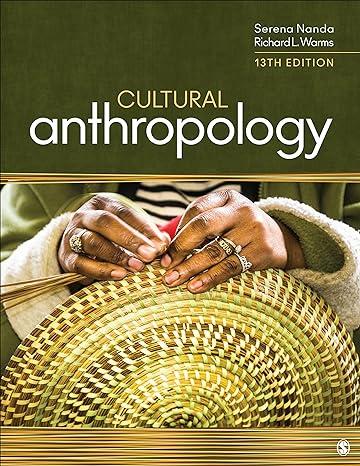Hijras are followers of a Hindu goddess, Bahuchara Mata, and the hijra subculture is partly a religious
Question:
Hijras are followers of a Hindu goddess, Bahuchara Mata, and the hijra subculture is partly a religious group centered on the worship of this goddess. By dressing as women, and especially through emasculation as a ritual expression of their religious devotion, the hijras attempt to completely identify with the goddess. Through this operation, the hijras believe that the procreative powers of the goddess are transferred to them. The first official government count of hijra, held in 2014, identified 490,000 hirjas in India (Nagarajan, 2014). There are also hijras in Pakistan and Bangladesh.
Traditionally, the hijras earn their living by performing at lifecycle ceremonies, such as the birth of a child (formerly only for male children, who are much desired in India, but sometimes for female children today), and at weddings. Because the hijras are vehicles of the goddess's powers of procreation, many people understand their presence as necessary on these occasions. They ask the goddess to bless the newborn or the married couple with prosperity and fertility. Hijras also serve the goddess in her temples.
Although the word hijra is sometimes translated as
hermaphrodite, few hijras are born hermaphrodite; almost all are born biologically male. Because impotence was a marker of failed masculinity in Victorian Britain, colonial authorities often classed hijra as impotent men. However, in India, hijras were understood as either unable or disinclined to have sex with women (Hinchy, 2013). In some parts of India, people believe that if such men do not become hijra, they will be reborn impotent for seven future lives.
The concept of the hijra as neither man nor woman emphasizes that hijras are not men because they cannot function sexually as men, even though they were assigned to the male sex at birth. Hijras also claim that they do not have sexual feelings for women, and a real hijra is not supposed to have ever had sexual relations with a woman. But if hijras, as a third gender, are man minus man, they are also man plus woman.
The most obvious aspect of hijras as women is in their dress.
Hijras have also been hit very hard by the COVID-19 pandemic. Their livelihoods were decimated by periods of lockdown, and they faced high levels of housing discrimination. A disinformation campaign in the city of Hyderabad blamed hijras for spreading COVID-19. Because hijras mostly work outside of the formal economy, relief payments rarely reached them. In some places, local governments took steps specifically aimed at aiding the hijra community, including establishing separate hospital wards for them, but the efforts were meager compared to the need (Baumgart \& Farooqi, 2020).
The continued recognition of hijras in Indian society is a strong testimony to the cultural construction of gender. Unlike many other traditional alternative genders among indigenous peoples that have been stamped out or repressed by the powerful states in which they now live, the hijras continue both in their traditional roles and in new roles, contributing to the cultural variation that characterizes the human species.
Questions
1. How does a study of the hijras contribute to an understanding of gender as culturally constructed?
2. Discuss some of the similarities and differences between the hijras and similar gender roles in other societies.
3. In what ways do elements of Indian culture relate to the maintenance of the hijra role?
Step by Step Answer:






